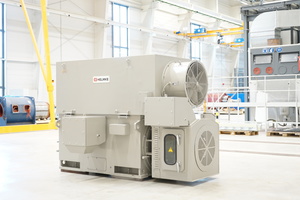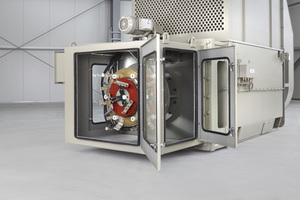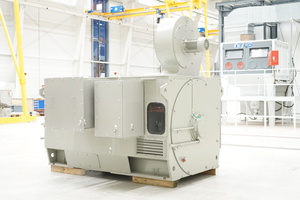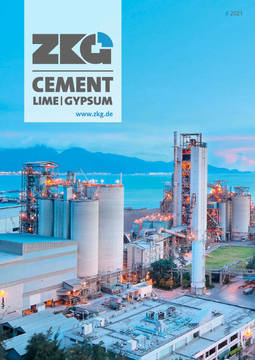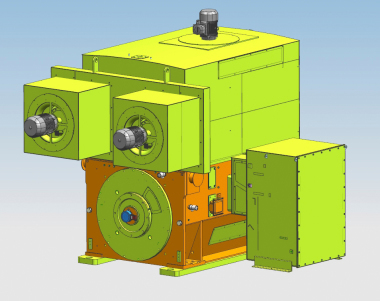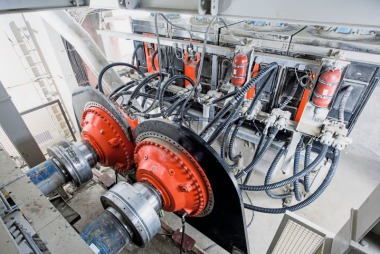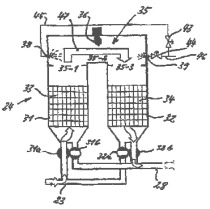A new solution for old challenges: Helmke slip-ring motors
Slip-ring motors (known as wound-rotor motors in the USA) have been used for many decades as prime mover machines in cases where high starting torques with low starting currents are needed.
Introduction
The development of the slip-ring rotor motor can be traced back to the investigative and development work performed by Michail Ossipowitsch Doliwo-Dobrowolski at AEG in 1890 and 1891. Dobrowolski invented, inter alia, the three-phase transformer and the present-day customary three-phase alternating-current system, along with its German designation of “three phase supply system” and the most important industrial motor, the asynchronous motor type. In the context of developing the squirrel-cage rotor, Doliwo-Dobrowolski recognised that the low starting torque could be improved by increasing the resistance of the rotor circuit. For this purpose, the rotor windings were routed out via slip rings and externally adjustable resistances switched in symmetrically by means of tap changers, depending on motor speed and load torque.
In subsequent decades, this style of machine spread into use in practically all applications which, indeed, required high starting torques, a low grid load at starting and, in some cases, also matching of motor nominal speed to the speed of the process driven.
The state of development today
In many applications, these requirements are nowadays achieved by means of modern frequency converters in combination with, for example, asynchronous motors. In a whole series of cases, however, especially in the case of higher power ratings, these benefits are still not available via the use of drive systems based on power electronics, with the result that slip-ring motors, with their undisputed technical and economic benefits even today, continue in use.
These benefits are clouded, however, by the relatively high requirements for inspection and maintenance of slip rings and carbon brushes.
Like all electrical equipment, these components developed in the course of decades into reliable and low-wearing parts.
The bandwidth of applications for carbon-brush systems shrank though with the reducing use of slip-ring motors and direct-current machines (with similar problems). The richness of the experience of manufacturers and operators is also shrinking continuously, despite the fact that technological and legal boundary conditions continue to develop further nonetheless across time.
Increasing power density in drive motors, the greater demands for protection against impurities and the availability of alternative materials, including, for instance, the omission of any lead content to support lubrication in the carbon brushes, have repeatedly necessitated changes to the “carbon brush and slip ring” system.
The machine design including slip-ring compartment with ingress protection IP55 (dust-protected) has, for its part, exercised a great influence on the cooling of the brushes, the removal of the abraded brush dust occurring, and also on the influencing climatic factors such as the necessary absolute (not relative) air humidity necessary for efficient lubrication on the running surfaces of the brushes.
Corrosive vapours, gases, oils and hydrocarbons, and also particulates, are other influencing factors which can result in elevated brush wear.
In order that the slip-ring motor functions optimally and with minimum wear of the slip rings and carbon brushes, it is necessary to take account of the most diverse criteria at commissioning and during the service phase.
There can be many different causes for problems in the brush/slip ring system. In the very simplest case, this is reflected in elevated brush consumption. Good systems operate with a rate of carbon-brush wear of around 5 to 10 mm per 1000 hours of operation (all depending on the application). The brush-consumption-data recording and analysis process should be performed across a longer period, since the complete formation of patina (a thin protective layer of mainly carbon material on slip-rings) and thus steady-state conditions are generally achieved only after around 1000 hours of operation.
There may be various reasons for higher levels of brush consumption, and these can also occur in combination. Irregularities, asymmetries and several other defficiencies can accumulate and can, in the longer term, also result very quickly in serious damage.
Each and every application requires individual consideration of which and how many carbon brushes should be selected, referred to load, current, voltage, temperature and ambient conditions.
There is no universal solution
Helmke, one of the most experienced manufacturers of slip-ring motors, particularly for large and very large power ratings, has now compiled its 100 years of field service and experience and drafted a special analytical system.
In the context of this analysis, not only the carbon brushes, but also the operating and environmental conditions are precisely analysed for their effects on wear behaviour.
In addition, Helmke has also developed a new carbon-brush apparatus which assures a very high level of robustness and simplicity. This carbon-brush apparatus achieves optimum balancing of the current in the individual brush and thus the homogenisation of brush consumption, while the risk of selective current distribution is reduced.
The symmetrical current flow supports uniform patina (protective film) formation on the slip rings, which is, inter alia, an important factor in reducing carbon-brush abrasion.
The robust and uniform mechanical structure minimises all parasitic side-effects, which could promote sudden peaks in the brush consumption rate.
Resistors installed upstream of the carbon brushes have been deliberately omitted in the design.
A greater need for cooling in the slip-ring compartment is not necessary, therefore, due to the absence of additional heat losses associated with the resistors, and a resultant reduction of efficiency is also avoided.
Another great advantage of the Helmke design is the fact that the unnecessary and space-consuming series resistors thus do not obstruct free access to the carbon brushes and the slip-ring assemblies in case of inspection and maintenance work.
All this experience has been incorporated not only into Helmke’s individual machine design and new series of motors.
The Helmke analysis also facilitates the drafting of proposed solutions for all slip-ring motor systems and the modification even of foreign makes and also in applications involving confined spaces and unstable, highly variable ambient conditions.
The Helmke analysis has been used to test the most diverse range of slip-ring motor systems. The findings gathered have been utilised for a systematic drive-system-level optimisation and modifications. The cost-savings thus achieved, resulting from reduced maintenance input and lower carbon-brush consumption, are significant.
Conclusion
The slip-ring motor with its in some cases still unparalleled benefits has proven its worth in industry for decades. In view of the particular operating conditions and the application- and customer-specific adaptations therefore possible and necessary, it will continue to be an important drive unit offering high efficiency and process reliability.

